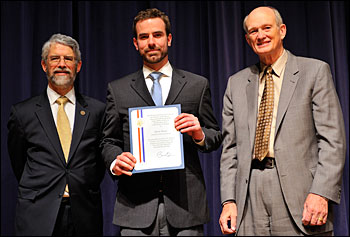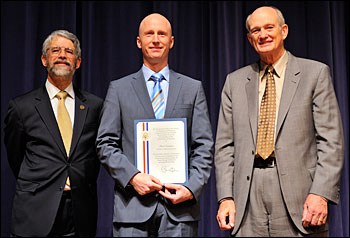Two Brookhaven Lab Scientists Receive Presidential Early Career Awards for Scientists and Engineers
July 14, 2009
UPTON, NY — Two scientists at the U.S. Department of Energy’s (DOE) Brookhaven National Laboratory — Jason Graetz and Paul Sorensen — were among 100 researchers who were named recipients of the Presidential Early Career Award for Scientists and Engineers, the highest honor bestowed by the U.S. government on young professionals in the early stages of their independent research careers.
Nine federal departments and agencies support the honorees, and DOE’s Office of Science and the National Nuclear Security Administration provided funding for 12 of the award recipients. The honorees will receive their awards, which include a citation, a plaque, and up to a five-year research grant to further their study in support of critical government missions, at a White House ceremony in the fall.
“The Department of Energy has scores of outstanding people working hard every day on critical and innovative scientific research,” said Secretary of Energy Steven Chu. “Their talents are contributing to the discoveries that will help chart America’s energy future and combat climate change. Each of these honorees has made a unique contribution to fulfilling the Department’s mission and I congratulate them on their accomplishment.”
 enlarge
enlarge
Jason Graetz (center) receives the Presidential Award from the Director of the Office of Science and Technology John Holdren (left). Joining them is Director of the U.S. Department of Energy 's Office of Science William Brinkman. (Photo courtesy of Ken Shipp/DOE Photo)
Using x-rays at Brookhaven’s National Synchrotron Light Source to probe materials at the atomic level, Jason Graetz and colleagues made significant strides in understanding how transition metals interact with reversible complex metal hydrides to catalyze the release and re-absorption of hydrogen. A better understanding of how atoms and molecules move around during the charge and discharge process may lead to new materials with improved hydrogen-storage properties. Graetz and collaborators are developing new high-capacity hydrogen-storage materials for automotive fuel-cell applications. This project is currently focused on the synthesis and characterization of aluminum hydride, which stores hydrogen in only ten percent of the space required by conventional methods and releases hydrogen at low temperature.
Graetz’s outreach activities for which he was also cited include mentoring both undergraduate and postgraduate students, organizing a symposium for the American Physical Society, and giving lectures about his work for Brookhaven employees and the public.
“I am honored to receive this award, which would not have been possible without the dedication and creative insight of my talented colleagues at Brookhaven,” said Graetz. “I am very excited to be a small part of the monumental progress being made in hydrogen storage, and I look forward to the challenges ahead.”
Graetz earned a B.A. in physics from Occidental College in 1998 and an M.S. and Ph.D. in materials science from the California Institute of Technology (CIT) in 2000 and 2003, respectively. He was a postdoctoral fellow at CIT in 2003 and at Brookhaven Lab, from 2004 to 2006. He joined the staff of Brookhaven as an assistant materials scientist in 2006 and was promoted to associate materials scientist in 2007. Graetz is a U.S. expert in hydrogen storage for the International Energy Agency and was the recipient of 2006 Ewald Wicke Award for his work in physical chemistry of metal hydrides. He has co-authored 24 peer-reviewed publications and holds four patent applications.
 enlarge
enlarge
Paul Sorensen also received the Presidential Award from John Holdren and was congratulated by William Brinkman. (Photo courtesy of Ken Shipp/DOE Photo)
Paul Sorensen was recognized for his work in analyzing heavy-ion collisions at Brookhaven’s Relativistic Heavy Ion Collider (RHIC). In 2005, physicists at RHIC created the most perfect fluid in nature, called quark-gluon plasma, a hot, dense matter formed out of quarks and gluons that permeated the universe one microsecond after its birth. Sorensen played a key role in discovering that the flow of matter in the heavy-ion collisions is dominated by subatomic particles called quarks, indicating that quark-gluon plasma had been created. Sorensen’s ongoing research within the STAR collaboration at RHIC will aim to better understand the properties and phases of quark-gluon plasma.
Sorensen was also honored for his work within the collaboration, including two years of service as an elected junior member of the STAR Council. He has also served on several other STAR governing groups, and he has mentored several undergraduate and graduate students.
“This is fantastic,” Sorensen said. “You work on something because you find it interesting and exciting, you get to think about these fundamental questions, you get lots of help from people smarter than you along the way, then you get to go the White House to meet President Barack Obama. What an honor!”
After earning a B.S. in physics from the University of Nebraska – Lincoln, in 1996, Sorensen earned an M.S. and Ph.D. in physics, both from the University of California, Los Angeles, in 1999 and 2003, respectively. He was a postdoctoral researcher at DOE’s Lawrence Berkeley National Laboratory for two years before joining Brookhaven Lab in 2005 as a Goldhaber Distinguished Fellow. He became an associate physicist at Brookhaven in 2008. Sorensen is the lead author of 16 peer-reviewed publications accruing more than 1,000 citations, and author of two invited review articles. He received the 2004 RHIC-AGS Thesis Award presented by Stony Brook University and Battelle and the 2008 George E. Valley Jr. Prize from the American Physical Society.
2009-10987 | INT/EXT | Newsroom









